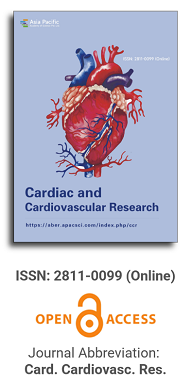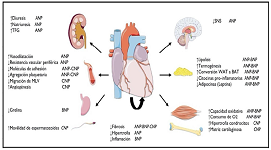
Asia Pacific Academy of Science Pte. Ltd. (APACSCI) specializes in international journal publishing. APACSCI adopts the open access publishing model and provides an important communication bridge for academic groups whose interest fields include engineering, technology, medicine, computer, mathematics, agriculture and forestry, and environment.

Drug-eluting stent and drug-coated balloon for in-stent restenosis: A meta-analysis
Vol 5, Issue 1, 2024
Download PDF
Abstract
The optimal strategy for patients with in-stent restenosis (ISR) is controversial. We aimed to compare the effects of a drug-coating balloon (DCB) and drug-eluting stent (DES) in ISR treatment. Clinical trials were extensively collected, and retrieved items were screened for inclusion. Both clinical (major adverse cardiac event (MACE); myocardial infarction (MI); and target lesion revascularization (TLR) and angiographic (minimal lumen diameter (MLD), and stenosis relative to reference lumen diameter (SRLD) endpoints were extracted and compared. MACE and MI were not significantly different between the groups. Pooled results of TLR showed a marginal effect that DES was superior to DCB (13.50% for DCB vs. 11.17% for DES, RR = 1.256, 95% CI: 0.997 to 1.583, P = 0.053), with heterogeneity across studies (I2 = 42.0%, Cochrane Q-test = 0.069). Meta-regression identified bare metal stent (BMS) or drug eluting stents (DES) implanted in the previous intervention and proportions of diabetes in the DCB group as sources of heterogeneity. DES implantation also significantly improved angiographic outcomes (WMD for MLD: −0.318, 95% CI: −0.424 to −0.213, P < 0.001; WMD for SRLD: 6.164%, 95% CI: 4.915% to 7.412%, P < 0.001). All DES, including everolimus-eluting ones, did not benefit BMS-ISR patients compared with DCB treatment. DES implantation, which is superior to DCB angioplasty only in DES-ISR patients, should be preferred in the DES-ISR population to reduce TLR. DCB may be preferred in BMS-ISR to avoid increasing stent layers.
Keywords
References
- Cassese S, Byrne RA, Tada T, et al. Incidence and predictors of restenosis after coronary stenting in 10004 patients with surveillance angiography. Heart. 2014; 100(2): 153–159.
- Sethi A, Malhotra G, Singh S, Singh PP, Khosla S. Efficacy of various percutaneous interventions for in-stent restenosis: comprehensive network meta-analysis of randomized controlled trials. Circulation: Cardiovascular Interventions. 2015; 8(11): e002778.
- Siontis GC, Stefanini GG, Mavridis D, et al. Percutaneous coronary interventional strategies for treatment of in-stent restenosis: a network meta-analysis. Lancet. 2015; 386(9994): 655–664.
- Windecker S, Kolh P, Alfonso F, et al. 2014 ESC/EACTS Guidelines on myocardial revascularization: The Task Force on Myocardial Revascularization of the European Society of Cardiology (ESC) and the European Association for Cardio-Thoracic Surgery (EACTS)Developed with the special contribution of the European Association of Percutaneous Cardiovascular Interventions (EAPCI). European Heart Journal. 2014; 35(37): 2541–2619.
- Bajraktari G, Jashari H, Ibrahimi P, et al. Comparison of drug-eluting balloon versus drug-eluting stent treatment of drug-eluting stent in-stent restenosis: A meta-analysis of available evidence. International Journal of Cardiology. 2016; 218: 126–135.
- Giacoppo D, Gargiulo G, Aruta P, Capranzano P, et al. Treatment strategies for coronary in-stent restenosis: systematic review and hierarchical Bayesian network meta-analysis of 24 randomised trials and 4880 patients. BMJ. 2015; 351: h5392.
- Alfonso F, Pérez-Vizcayno MJ, García DBB, et al. Long-Term Results of Everolimus-Eluting Stents Versus Drug-Eluting Balloons in Patients with Bare-Metal In-Stent Restenosis: 3-Year Follow-Up of the RIBS V Clinical Trial. JACC: Cardiovascular Interventions. 2016; 9(12): 1246–1255.
- Xu B, Qian J, Ge J, et al. Two-year results and subgroup analyses of the PEPCAD China in-stent restenosis trial: A prospective, multicenter, randomized trial for the treatment of drug-eluting stent in-stent restenosis. Catheterization and Cardiovascular Interventions. 2016; 87 Suppl 1: 624–629.
- Unverdorben M, Vallbracht C, Cremers B, et al. Paclitaxel-coated balloon catheter versus paclitaxel-coated stent for the treatment of coronary in-stent restenosis: the three-year results of the PEPCAD II ISR study. EuroIntervention. 2015; 11(8): 926–934.
- Yta W, Kang DY, Lee JB, et al. Comparison of drug-eluting stents and drug-coated balloon for the treatment of drug-eluting coronary stent restenosis: A randomized RESTORE trial. American Heart Journal. 2018; 197: 35–42.
- Page MJ, McKenzie JE, Bossuyt PM, et al. The PRISMA 2020 statement: an updated guideline for reporting systematic reviews. BMJ. 2021; 372: n71.
- Zhang XL, Zhu QQ, Yang JJ, et al. Percutaneous intervention versus coronary artery bypass graft surgery in left main coronary artery stenosis: a systematic review and meta-analysis. BMC Medicine. 2017; 15(1): 84.
- DerSimonian R, Laird N. Meta-analysis in clinical trials. Controlled Clinical Trials. 1986; 7(3): 177–188.
- Mantel N, Haenszel W. Statistical aspects of the analysis of data from retrospective studies of disease. Journal of the National Cancer Institute. 1959; 22(4): 719–748.
- Begg CB, Mazumdar M. Operating characteristics of a rank correlation test for publication bias. Biometrics. 1994; 50(4): 1088–1101.
- Zhang HF, Zhong BL, Zhu WL, et al. CD14 C-260T gene polymorphism and ischemic heart disease susceptibility: a HuGE review and meta-analysis. Genetics in Medicine. 2009; 11(6): 403–408.
- Jackson D, Turner R. Power analysis for random-effects meta-analysis. Research Synthesis Methods. 2017; 8: 290–302.
- Pleva L, Kukla P, Kusnierova P, et al. Comparison of the Efficacy of Paclitaxel-Eluting Balloon Catheters and Everolimus-Eluting Stents in the Treatment of Coronary In-Stent Restenosis: The Treatment of In-Stent Restenosis Study. Circulation: Cardiovascular Interventions. 2016; 9(4): e003316.
- Kawamoto H, Ruparelia N, Latib A, et al. Drug-Coated Balloons Versus Second-Generation Drug-Eluting Stents for the Management of Recurrent Multimetal-Layered In-Stent Restenosis. JACC Cardiovascular Interventions. 2015; 8(12): 1586–1594.
- Kang IS, Shehata I, Shin DH, et al. Comparison between drug-coated balloon angioplasty and second-generation drug-eluting stent placement for the treatment of in-stent restenosis after drug-eluting stent implantation. Heart and Vessels. 2016; 31(9): 1405–1411.
- Alfonso F, Pérez-Vizcayno MJ, Cárdenas A, et al. A Prospective Randomized Trial of Drug-Eluting Balloons Versus Everolimus-Eluting Stents in Patients with In-Stent Restenosis of Drug-Eluting Stents: The RIBS IV Randomized Clinical Trial. Journal of the American College of Cardiology. 2015; 66(1): 23–33.
- Kufner S, Cassese S, Valeskini M, et al. Long-Term Efficacy and Safety of Paclitaxel-Eluting Balloon for the Treatment of Drug-Eluting Stent Restenosis: 3-Year Results of a Randomized Controlled Trial. JACC Cardiovascular Interventions. 2015; 8(7): 877–884.
- Naber C, Erglis A, Gorss M, et al. Clinical performance of the Pantera LUX paclitaxel releasing balloon vs. the drug-eluting Orsiro hybrid stent system in patients with in-stent restenosis: a randomised controlled trial (BIOLUX RCT).Available online: https: //clinicaltrials.gov/ct2/show/NCT01651390 (accessed on 2 January 2024).
- Adriaenssens T, Dens J, Ughi G, et al. Optical coherence tomography study of healing characteristics of paclitaxel-eluting balloons vs. everolimus-eluting stents for in-stent restenosis: the SEDUCE (Safety and Efficacy of a Drug elUting balloon in Coronary artery rEstenosis) randomised clinical trial. EuroIntervention. 2014; 10(4): 439–448.
- Kang SJ, Mintz GS, Park DW, et al. Mechanisms of in-stent restenosis after drug-eluting stent implantation: intravascular ultrasound analysis. Circulation: Cardiovascular Interventions. 2011; 4(1): 9–14.
- Mamuti W, Ablimit A, Kelimu W, et al. Comparison of drug-eluting balloon versus drug-eluting stent in patients with in-stent restenosis: insight from randomized controlled trials. International Journal of Cardiology. 2015; 179: 424–429.
- Cai JZ, Zhu YX, Wang XY, et al. Comparison of new-generation drug-eluting stents versus drug-coated balloon for in-stent restenosis: a meta-analysis of randomised controlled trials. BMJ Open. 2018; 8(2): e017231.
- Habara S, Iwabuchi M, Inoue N, et al. A multicenter randomized comparison of paclitaxel-coated balloon catheter with conventional balloon angioplasty in patients with bare-metal stent restenosis and drug-eluting stent restenosis. American Heart Journal. 2013; 166(3): 527–533.
- Habara S, Kadota K, Shimada T, et al. Late Restenosis After Paclitaxel-Coated Balloon Angioplasty Occurs in Patients with Drug-Eluting Stent Restenosis. Journal of the American College of Cardiology. 2015; 66(1): 14–22.
- Wöhrle J, Zadura M, Möbius-Winkler S, et al. SeQuentPlease World Wide Registry: clinical results of SeQuent please paclitaxel-coated balloon angioplasty in a large-scale, prospective registry study. Journal of the American College of Cardiology. 2012; 60(18): 1733–1738.
- Goto K, Zhao Z, Matsumura M, et al. Mechanisms and Patterns of Intravascular Ultrasound In-Stent Restenosis Among Bare Metal Stents and First- and Second-Generation Drug-Eluting Stents. The American Journal of Cardiology. 2015; 116(9): 1351–1357.
- Nakazawa G, Otsuka F, Nakano M, et al. The pathology of neoatherosclerosis in human coronary implants bare-metal and drug-eluting stents. Journal of the American College of Cardiology. 2011; 57(11): 1314–1322.
- Iglesias JF, Muller O, Zaugg S, et al. A comparison of an ultrathin strut biodegradable polymer sirolimus-eluting stent with a durable polymer everolimus-eluting stent for patients with acute stsegment elevation myocardial infarction undergoing primary percutaneous coronary intervention: rationale and design of the BIOSTEMI trial. EuroIntervention. 2017.
- Yano H, Horinaka S, Ishimitsu T. Impact of everolimus-eluting stent length on long-term clinical outcomes of percutaneous coronary intervention. Journal of Cardiology. 2018; 71(5): 444–451.
Supporting Agencies
Copyright (c) 2024 Wen-Hao Liu, Run-Lu Sun, Qian Chen, Hong-Wei Li, Hai-Feng Zhang, Zhao-Xi Cai
License URL: https://creativecommons.org/licenses/by/4.0/

This site is licensed under a Creative Commons Attribution 4.0 International License (CC BY 4.0).

Prof. Prakash Deedwania
University of California,
San Francisco, United States




